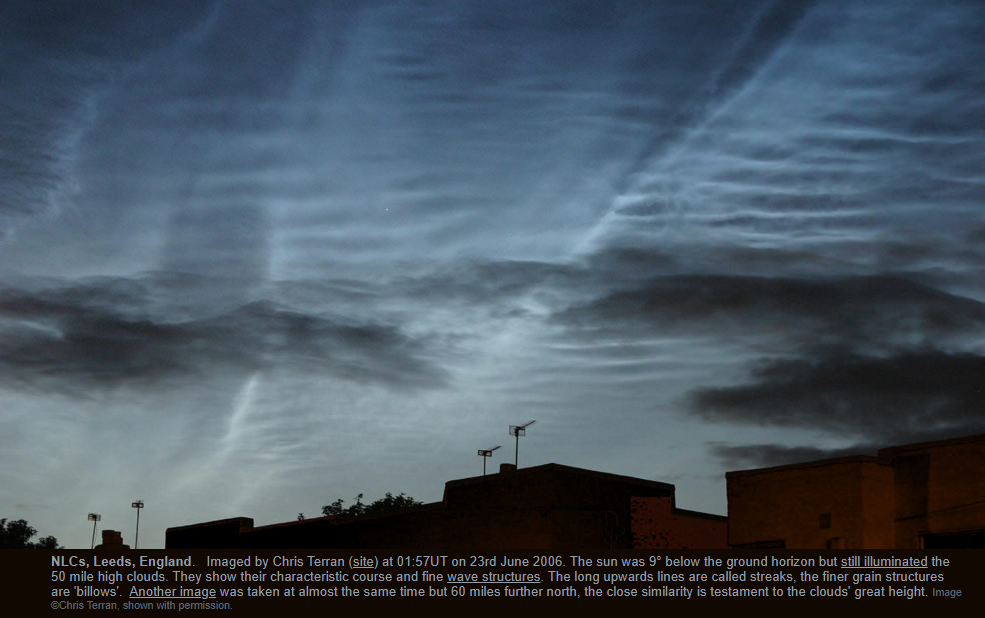Noctilucent Clouds, Leeds, England
Noctilucent Clouds: A Spectacular Phenomenon in Leeds, England
Noctilucent clouds (NLCs) are a mesmerizing atmospheric phenomenon that can be observed in various parts of the world, including Leeds, England. These unique clouds, also known as polar mesospheric clouds, appear in the twilight sky during the summer months and display a stunning array of colors and patterns. They are composed of ice crystals that form at extremely high altitudes, around 50 miles above the Earth's surface.
The Beauty of Noctilucent Clouds
One of the captivating aspects of NLCs is their luminosity. Even though the sun is below the horizon, its rays manage to illuminate these ethereal clouds, creating a breathtaking spectacle. The delicate structures of NLCs are characterized by both coarse streaks and fine wave patterns, giving them a distinct appearance. The streaks, which are long upward lines, contrast with the billows, which are finer grain structures. Together, they contribute to the captivating beauty of these clouds.
Extreme Altitude and Similarity in Different Locations
The altitude at which noctilucent clouds form is truly remarkable. At around 50 miles above the ground, they reside in the mesosphere, the third layer of the Earth's atmosphere. This height is significantly higher than other cloud types, which typically form in the troposphere or stratosphere. The fact that these clouds can be observed in Leeds, England, and even as far as 60 miles north, highlights their incredible height and resilience.
The Mystery Behind Noctilucent Cloud Formation
The formation of NLCs is still not fully understood by scientists. However, several factors contribute to their creation. It is believed that the presence of water vapor, dust particles, and low temperatures in the mesosphere play a crucial role in the formation of these unique clouds. The specific conditions required for NLC formation make them a rare occurrence, further adding to their allure.
Noctilucent Clouds and Climate Change
The study of NLCs is not only captivating but also holds significance in understanding climate change. As these clouds form in the mesosphere, changes in their frequency and intensity can provide valuable insights into variations occurring in the upper atmosphere. Scientists have observed an increase in the occurrence of NLCs in recent years, potentially indicating shifts in atmospheric conditions due to human activities.
Capturing the Beauty of Noctilucent Clouds
Photographers and sky enthusiasts alike have marveled at the captivating beauty of NLCs. The unique combination of their luminosity, intricate structures, and vibrant colors make them a popular subject for photography. Capturing the ethereal nature of these clouds requires careful planning and timing, as they are only visible during the summer months and within specific latitudes.
The Global Appeal of Noctilucent Clouds
While Leeds, England, offers a remarkable vantage point for observing NLCs, these clouds can be seen in various locations across the globe. Polar and near-polar regions, such as Scandinavia, Canada, and Alaska, are particularly favorable for witnessing this celestial phenomenon. The global appeal of NLCs has sparked interest and awe among people from different cultures and backgrounds.
Citizen Science and Noctilucent Cloud Observations
Noctilucent clouds have also become a subject of citizen science initiatives. Skywatchers around the world contribute to the study of NLCs by reporting their observations and sharing photographs. These collective efforts help scientists gain a better understanding of the distribution and behavior of these clouds, furthering our knowledge of Earth's upper atmosphere.
Appreciating Nature's Spectacles
Noctilucent clouds serve as a reminder of the awe-inspiring wonders that nature has to offer. Their elusive nature, combined with their striking appearance, makes them a truly captivating phenomenon. Whether observed in Leeds, England, or in other parts of the world, these ethereal clouds continue to mesmerize and inspire those fortunate enough to witness their beauty.
Conclusion
Noctilucent clouds are a fascinating atmospheric phenomenon that grace the skies of Leeds, England, during the summer months. Their extreme altitude, luminosity, and intricate structures make them a truly captivating sight. As scientists continue to study and unravel the mysteries behind NLC formation, their significance in understanding climate change becomes increasingly apparent. Whether through scientific research or the appreciation of their beauty through photography, noctilucent clouds have captivated people around the world, reminding us of the wonders that nature has in store for us.

NLCs, Leeds, England. Imaged by Chris Terran (site) at 01:57UT on 23rd June 2006. The sun was 9° below the ground horizon but still illuminated the 50 mile high clouds. They show their characteristic course and fine wave structures. The long upwards lines are called streaks, the finer grain structures are 'billows'. Another image was taken at almost the same time but 60 miles further north, the close similarity is testament to the clouds' great height. Image ©Chris Terran, shown with permission.
Note: this article has been automatically converted from the old site and may not appear as intended. You can find the original article here.
Reference Atmospheric Optics
If you use any of the definitions, information, or data presented on Atmospheric Optics, please copy the link or reference below to properly credit us as the reference source. Thank you!
-
<a href="https://atoptics.co.uk/blog/noctilucent-clouds-leeds-england/">Noctilucent Clouds, Leeds, England</a>
-
"Noctilucent Clouds, Leeds, England". Atmospheric Optics. Accessed on November 26, 2024. https://atoptics.co.uk/blog/noctilucent-clouds-leeds-england/.
-
"Noctilucent Clouds, Leeds, England". Atmospheric Optics, https://atoptics.co.uk/blog/noctilucent-clouds-leeds-england/. Accessed 26 November, 2024
-
Noctilucent Clouds, Leeds, England. Atmospheric Optics. Retrieved from https://atoptics.co.uk/blog/noctilucent-clouds-leeds-england/.